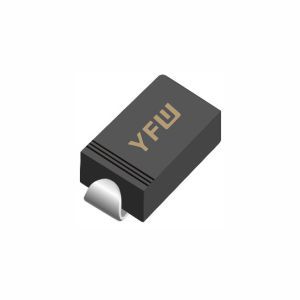Diode clipping circuits, also known as limiters, are designed to restrict the amplitude of input signals to a predefined range. This is achieved by leveraging the diode’s nonlinear I-V characteristics. When forward-biased, a diode conducts and clamps the voltage to its forward voltage drop (e.g., 0.7V for silicon diodes), while a reverse-biased diode blocks current, allowing the input signal to pass unaltered. This behavior forms the basis of both
series and
shunt clipping configurations .
Positive Clippers: These circuits remove the positive half-cycle of the input waveform. When the input voltage exceeds the diode’s forward voltage, the diode conducts, limiting the output voltage to ~0.7V. YFW’s fast-recovery diodes, such as the US2M (1A, 1000V, 75ns recovery time) , ensure minimal distortion in high-frequency applications.
Negative Clippers: Conversely, these circuits suppress the negative half-cycle. YFW’s SS34 Schottky diode (3A, 40V, 550mV forward voltage) is ideal for low-voltage applications due to its ultra-low forward drop, reducing power loss.
Positive Shunt Clippers: The diode is placed in parallel with the load. During the positive half-cycle, the diode conducts, shorting the output and clipping the signal. YFW’s 1N5817W Schottky diode (3A, 120V, 0.8V forward voltage) is optimized for high-efficiency rectification and clipping in compact designs.
Negative Shunt Clippers: These circuits clip the negative half-cycle. YFW’s FR107WS fast-recovery diode (1A, 1000V, 500ns recovery time) offers reliable performance in high-voltage scenarios.
By integrating a DC bias voltage, clipping levels can be precisely adjusted. For example, a positive-biased clipper with YFW’s BZX84B12VL Zener diode (12V, 250mW) allows clipping at specific voltage thresholds, making it suitable for voltage regulation in analog circuits.
Using two diodes in inverse parallel, bidirectional clippers limit both positive and negative peaks. YFW’s MUR1040DFR fast-recovery bridge rectifier (10A, 400V) is designed for full-wave clipping in power supplies, ensuring stable output under varying loads.
Zener diodes, like YFW’s MM1W165 (16V, 1W) , exploit reverse breakdown to provide precise voltage clamping. Their ability to maintain a constant voltage in reverse bias makes them indispensable for overvoltage protection in automotive and industrial systems .
YFW’s ES2JF ultrafast diode (2A, 600V, 35ns recovery time) is engineered for high-frequency switching, minimizing energy loss and ensuring clean signal clipping in applications like inverters and motor drives.
Low Forward Voltage: YFW’s Schottky diodes, such as the SS34, feature forward voltages as low as 0.55V, enhancing energy efficiency in battery-powered devices.
Fast Recovery: With recovery times as short as 30ns (e.g., ES2DF) , YFW diodes reduce switching losses in high-frequency circuits.
High Voltage Handling: Products like the 20A10TB (20A, 1000V) are designed for robust performance in high-voltage environments, ensuring reliable clipping under extreme conditions.
Compact Packaging: SOD123FL and SMA packages (e.g., US1MW) enable space-efficient designs without compromising performance.
Diode clipping finds extensive use in:
Signal Conditioning: Audio amplifiers and sensor interfaces rely on clippers to prevent waveform distortion.
Power Electronics: Overvoltage protection in solar inverters and automotive charging systems.
Communication Systems: Clipping circuits in RF receivers safeguard sensitive components from high-power transients .
YFW’s diode clipping solutions combine cutting-edge engineering with rigorous quality control, delivering precision, efficiency, and reliability across diverse applications. Whether for low-voltage consumer electronics or high-power industrial systems, our diodes ensure optimal waveform shaping and voltage regulation. Explore YFW’s range of clipping diodes at
www.yfwdiode.com to discover how we empower next-generation circuit design.
For more technical resources and product specifications, visit our official website or contact our engineering team.
